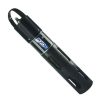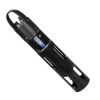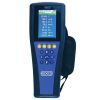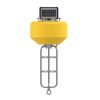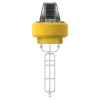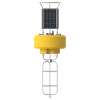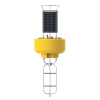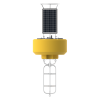YSI EXO1s Multi-Parameter Water Quality Sonde
Features
- Ideal for spot sampling or attachment to data buoys, AUV's, drones, etc.
- Smaller, lighter sondes can be deployed in tight spaces
- A more budget-friendly EXO without alkaline batteries
- Expedited repair and warranty service
- Lifetime technical support
- More
Overview
The YSI EXO represents the next generation of water quality instruments from YSI. The advanced sonde platform offers a wide range of capabilities to those dedicated to monitoring natural aquatic environments such as oceans, estuaries, rivers, lakes, and groundwater. With a highly efficient power management platform, robust construction, and chemistry-free anti-fouling system, EXO allows accurate data collection for up to 90 days between service intervals.
Parameters
The EXO1s sonde includes four sensor ports with internal data logging. Sensor parameters include temperature, conductivity, depth, dissolved oxygen, pH, ORP, total algae (phycocyanin or phycoerythrin along with chlorophyll), turbidity, fluorescent dissolved organic matter (fDOM), Rhodamine WT, UV nitrate, ISE ammonium, ISE nitrate, and ISE chloride. The sonde can also output four calculated parameters including salinity, specific conductance, total dissolved solids (TDS) and total suspended solids (TSS).
Mechanics
All EXO sensors are digital sensors with on-board signal processing and memory. Built-in sensor diagnostic and calibration data allows users to calibrate multiple sensors in one sonde and distribute to various other sondes in the field. Wet-mateable connectors allow for swaps in wet conditions, while active port monitoring automatically detects each sensor and verifies operation.
EXO1s Specifications
Diameter: 4.75cm (1.87 in)
Length (with guard): 44.77cm (17.63 in) without depth sensor; 46.41cm (18.27 in) with depth sensor
Peripheral Ports: 1 power communication port
Sensor Ports: 4
3-Year Warranty: Sonde; handheld
2-Year Warranty: Cables; conductivity/temperature and optical sensors; electronics base for pH, pH/ORP, ammonium, chloride, and nitrate sensors
1-Year Warranty: Optical DO cap and replaceable reagent modules for pH and pH/ORP sensors
3-Month Warranty: Replaceable reagent modules for ammonium, chloride, and nitrate sensors
Weight: 0.48kg (1.06 lbs) without depth sensor; 0.56kg (1.24 lbs) with depth sensor
General Sonde Specifications
Power Requirement: 9-16 VDC
Computer Interface: YSIP via USB Signal Output Adapter (SOA) and Bluetooth
Output Options: RS-232 & SDI-12 via DCP-SOA; Modbus & RS-485 via Modbus-SOA
Data Memory: 512 MB total memory; >1,000,000 Logged readings
Depth Rating: 0 to 250m (0 to 820 ft)
Sample Rate: Up to 4 Hz
Operating Temperature: -5 to +50°C (23 to 122°F)
Storage Temperature: -20 to +80°C (-4 to 176°F)
- (1) EXO1s sonde
- (1) Probe guard
- (1) Calibration cup
- (1) Tool kit
- (2) Port plugs
- (1) USB drive loaded with manual & Kor Software
In The News
2025 Essential Water Monitoring Gear
Stay ahead of the curve with five of the top water monitoring products for 2025. Technological advancements and manufacturing innovations are leading to better quality data, improved price points, and enhanced user experience. And, while the ‘essentials’ list includes several new products, two tried-and-true measurement instruments continue to take a top spot for portable instrumentation. These five products were developed by industry-leading suppliers, and in addition to extensive manufacturer testing, our science team tested and verified each instrument’s performance at the Fondriest Center for Environmental Studies .
Read MoreYSI ProDSS Multi-Parameter Water Quality Meter Review
There's no shortage of options when it comes to water quality monitoring equipment. If you're looking for an all-in-one multi-parameter sampling meter, then the YSI ProDSS is a prime choice. Along with its field-rugged construction, backlit display, rechargeable battery, a wide selection of cable lengths and a long list of measurement parameters, the meter offers the latest in smart sensor technology. Constructed of titanium and laser welded, the smart sensors offer superior performance in fresh, brackish and saltwater applications. Upon connection, the smart sensors are automatically displayed on the meter. With internally stored calibration constants, any sensor can plug into any port and provide accurate data in just seconds.
Read MoreMonitoring Hurricanes and Predicting Flooding in the Age of Climate Change
Still recovering from Hurricane Helene, which caused extreme precipitation, flooding, landslides, and other environmental disasters associated with severe weather, the southeastern part of the U.S. is predicted to be hit by another storm, Hurricane Milton. With Hurricane Helene having made landfall only a little over a week ago on September 27 th , many communities are still recovering. ABC reports that over 230 people have been killed as a result of flooding and destruction caused by Helene, with many still missing. Residents in these heavily impacted states, such as Florida, Georgia, South Carolina, North Carolina, Virginia and Tennessee, are still searching through the rubble of homes, urban centers, and hospitals for loved ones and belongings.
Read More
















































